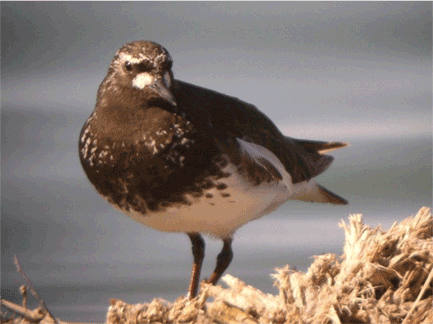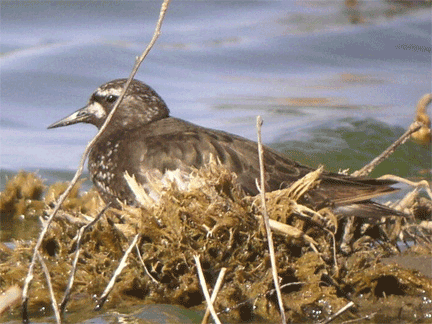 |
 |
|||||||||||||||||||||
|
||||||||||||||||||||||
FIRST OCCURRENCE OF BLACK TURNSTONE IN ARIZONA
Mark Stevenson, 4201 E. Monte Vista Dr. #J207, Tucson, AZ 85712, drbrdr@att.net
On the evening of 2 June 2005, Tucson birder Roger Eastman was birding at “Cochise Lake,” the large holding pond for treated wastewater south of the Twin Lakes Golf Course in Willcox, Cochise County. In the stubble and mud along the edge of the pond he spotted a Black Turnstone (Arenaria melanocephala) and immediately recognized that it was unexpected. Returning to the pond early the following morning he again observed the turnstone and phoned in a report and description of the bird to me. Word quickly went out on the Arizona-New Mexico bird listserv, allowing many birders to see and enjoy the bird during its brief stay. Photographs of the turnstone were obtained by Rich Ditch, Jeff Estis, and me and have been submitted to the Arizona Bird Committee for documentation. The Black Turnstone was last reported on 5 June 2005.

The Black Turnstone is an extremely rare vagrant in the interior west. Given the Willcox bird’s age and the date and location of the occurrence, it seems likely that it was a wandering, nonbreeding individual rather than an off-course adult migrant.
Photo by Mark Stevenson
The identification of Black Turnstone is straightforward when the bird is seen well. However, the related Ruddy Turnstone (Arenaria interpres) in basic plumage could cause confusion for inexperienced birders. In the Black Turnstone’s normal range and habitat, basic-plumaged Surfbird (Aphriza virgata) or Rock Sandpiper (Calidris ptilocnemis) may also cause uncertainty.
The Willcox bird was a medium-small shorebird with a short, tapering, finely pointed black bill, black eye, and short orange-brown legs. At rest, the upperparts were entirely black to brownish-black. There were fine white streaks on the crown, nape, sides of the neck, and cheeks. A bold white spot at the base of the bill was separated from the eye and supercilium by black feathers. The white supercilia nearly met on the forecrown. The breast was black, with a straight line of divide from the white belly. There were scattered white feathers within the upper black breast and scattered black feathers just below the black breast. The rest of the underparts were white. White edging was not apparent on the scapulars but was present on the median wing coverts as narrow white tips. At rest,
the tips of the primaries showed some brown tone over the black coloration. These brown tones and worn white tail tip suggest that this was a bird in its first spring (Paulson 1993). In flight, the bird showed the distinctive pattern of white longitudinal lower back stripe, black tail with a broad white base (photos of the perched bird showed a minimal white tail tip), and the wing black above with a white wing stripe and white humeral stripe.

The identification of Black Turnstone is straightforward when the bird is seen well. At rest, the Willcox bird showed primary tips with some brown tones over the black coloration. These brown tones and the worn white tail tips suggest this was a bird in its first spring.
Photo by Mark Stevenson
Black Turnstones breed on coastal tundra in western Alaska. Their winter range extends along the rocky Pacific Coast from northern Mexico to southeastern Alaska. Nonbreeding birds may remain in the winter range all year (Hayman et al. 1986). They are fairly common on rocky shores and reefs of the northern Gulf of California, chiefly from September to early April; a few have summered in Sonora (Russell and Monson 1998). North of the Gulf of California at the Salton Sea the Black Turnstone is nearly annual as a rare spring transient (late March to early June) and a casual fall transient (early July to early September), with a few summer and winter records (Patten et al 2003).
Away from the Salton Sea, the Black Turnstone is an extremely rare vagrant in the interior west, not surprising given its coastal distribution and that it does not breed or migrate across the northern coast of Alaska and Canada. The similar Ruddy Turnstone, which does breed across the north of the continent, has strayed to Arizona more than 30 times (Rosenberg and Witzeman 1998). Elsewhere in interior southern California, there are three May records and two early September records (G. McCaskie personal communication). There are also Black Turnstone records from as far inland as Montana and Wisconsin (Paulson 2005). A web search revealed no mention of the Black Turnstone on the checklists of inland states bordering Arizona with the exception of a single accepted Nevada sight record of one bird at Carson Lake 23 April 1998 (J. Cochran, personal communication). The closest previous record to Arizona was of one bird found by Gale Monson on the California side of Lake Havasu on 21 May 1948 (Monson and Phillips 1981).
Given the bird’s age and the date and location of this occurrence, it seems likely that the Willcox Black Turnstone was a wandering, nonbreeding individual rather than an off-course adult migrant.
Acknowledgments
Molly Pollock, Troy Corman, Roy Jones, and Rick Wright improved early drafts. Thanks to Guy McCaskie and Steven Mlodinow who provided information on records and to Roger Eastman for finding the bird and getting the word out on it.
Literature cited
Hayman, P., J. Marchant, and T. Prater et al. 1986. Shorebirds: An Identification Guide. Houghton Mifflin Co., Boston.
Monson, Gale and A.R. Phillips. 1981. Annotated Checklist of the Birds of Arizona. University of Arizona Press, Tucson.
Patten, M.A., G. McCaskie, P. Unitt. 2003. Birds of the Salton Sea. University of California Press, Los Angeles.
Paulson, Dennis. 1993. Shorebirds of the Pacific Northwest. University of Washington Press, Seattle---. 2005. Shorebirds of North America, The Photographic Guide. Princeton University Press, Princeton, NJ.
Rosenberg, G. and J. Witzeman. 1998. Arizona Bird Committee Report, 1974-1996: Part 1 (Non-passerines). Western Birds 29:199-224.
Russell, S.M. and G. Monson, 1998. The Birds of Sonora. University of Arizona Press, Tucson.
Published November 15, 2005
|
©2005
|
HOME | | | REPORT SIGHTINGS | | | PHOTOS | | | BIRDING | | | JOURNAL | | | ABOUT US | | | CHECKLISTS | | | AZ BIRD COMMITTEE | | | EVENTS | | | LINKS |